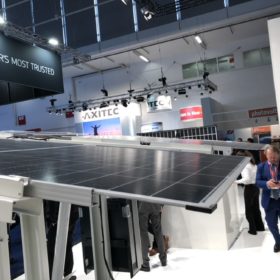
Trina Solar has made a PV cell by directly applying the unmodified i-TOPCon process, originally developed for Cz mono wafers, to cast n-type quasi-mono silicon wafers. It claims the average efficiency, tested in-house with a calibrated reference cell, is 22.98%.
Researchers from China’s State Key Lab of Photovoltaic Science and Technology, Trina Solar, and Australia-based Amrock Group have published a scientific paper that provides insight into how the panel manufacturer was able to achieve a 23.22% conversion efficiency and an open circuit voltage (Voc) of 711.9 mV for a bifacial polycrystalline solar cell developed with mono cast technology.
Trina announced the results, independently confirmed by ISFH CalTeC in Germany, in November 2019. The three parties described their findings in “Industrial TOPCon solar cells on n-type quasi-mono Si wafers with efficiencies above 23%,” recently published in Solar Energy Materials and Solar Cells. They applied a TOPCon design (industrial tunnel-oxide passivated contact) to a 2 x 2 square-centimeter area of an 157.4 mm x 157.4 mm quasi-mono n-type wafer with 180 μm thickness. They applied an alkaline cleaning and texture process to the wafer.
The wafer was passivated with a stacked dielectric film followed by a thermal treatment in a firing furnace to activate the passivation, after saw damage was removed. The effective lifetime of the wafer is said to be close to the bulk lifetime, due to the surface passivation; the scientists described this as “excellent.”
“The i-TOPCon process originally developed for Czochralski (Cz) mono wafers could be directly applied without modification to the cast quasi-mono wafers and provide excellent passivation on the front and rear side,” the researchers said.
They quantified the process difference between Cz monocrystalline material and cast mono material by preparing in parallel cells made by Cz and quasi-mono wafers. “By comparison, in the quasi-mono cells, the bulk recombination is dominating the power loss, while the losses at the front side are reduced and are proportionally less detrimental,” they explained.
They claimed that the average efficiency of the cell, tested in-house with a calibrated reference cell, is 22.98%. “The power loss analysis provided by Sinton FCT-450 confirmed that the bulk recombination of quasi-mono plays a dominating role, unlike in Cz mono cells, where the recombination in the emitter is mainly restricting the efficiency,” the scientists said, noting that the Sinton FCT-450 is a flash tester used for in-house IV measurements of solar cells.
The researchers said they could further optimize the cell efficiency in the future when the quality of bulk materials improves. “Further investigation shows that a low reverse saturation current density (J0) of front and rear could achieve a Voc over 710 mV even with the relatively low bulk lifetime,” they said.
Mono cast solar cells are produced with seeded cast silicon, which is also known as cast-mono or quasi-mono crystalline silicon. The cast mono process enables the production of ‘mono like’ wafer material using a modified multicrystalline furnace and avoids costly investment in ingot pulling machinery. Cast-mono wafers are less susceptible to recombination caused by boron-oxygen defects and have the advantage of lower light-induced degradation.
Cast mono manufacturing emerged at the beginning of the decade, but its importance has faded due to a lack of production line capacity. However, with more efficient monocrystalline panels surpassing multi as the industry standard, multicrystalline producers have returned to cast mono technology to avoid the expense of retooling their production capacities.
Canadian Solar said last year that it had achieved 22.8% efficiency for its p-type multicrystalline P5 solar cell, based on mono cast technology. Just a few months earlier, rival GCL Systems Integration had unveiled cast mono tech modules with 18.9% efficiency.
Lắp đặt điện mặt trời Khải Minh Tech
https://ift.tt/2X7bF6x
0906633505
info.khaiminhtech@gmail.com
80/39 Trần Quang Diệu, Phường 14, Quận 3
Lắp đặt điện mặt trời Khải Minh Tech
https://ift.tt/2ZH4TRU
Không có nhận xét nào:
Đăng nhận xét